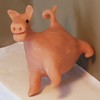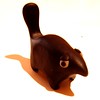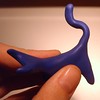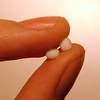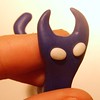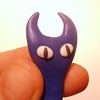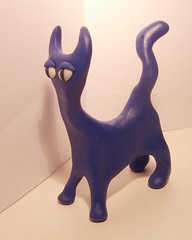Third Giant Puppet: Hati the Wolf
The Samhuinn Fire Festival in Edinburgh has more often than not featured a pack of wolves in one form or another – the Wild Hunt, hounding the spirits of Summer, is one of its recurring symbols, and for me has been one of the big highlights of the Samhuinns I have attended as an audience member.
The Wolves in 2010 were largely metaphorical, more lupine humans than humanoid wolves, but they still tore the vitals from our fantastical-animals Summer Troupe. This year the wolves were less numerous, but wolfier – just two of us with giant puppets.
When I started thinking about this year’s festival, I found myself with an unusually clear vision of the puppet-wolf I wanted to make. A lot of my art comes out of doodling to see what emerges, so when I do have a persistent creative vision, I tend to feel like I owe it to myself to make it happen. Pleasingly, this year’s Samhuinn was even more puppet-based than last year’s, with one large group of puppeteers where usually there are several separate performance groups. Here’s a gallery of puppetry photos from the night, and here are some photos of my puppet-making process.
My wolf would be mounted on a backpack frame, like my previous puppets, but this time the head would be a couple of feet above and in front of my own head. I had a collection of much thicker bendy sticks than our usual withies – presumably also willow – that I found in the street one time, and these would be my main construction material. They’re strong, but they have a lot of give in them, so the puppet has a great deal of movement in it – freed from the traditional bamboo skeleton, it bounces around of its own accord and takes a moment to settle back down after any sudden movement. It has its own rhythm, so the operator needs to work with its impulses rather than trying to control every motion.
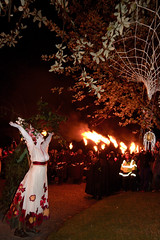 I made the head from the same thick aluminium wire I used for the tapir‘s head last year, and gave it something of a skeletal appearance by binding it in white cotton strips – offcuts from a t-shirt factory, I think, found in the Beltane Fire Society stores. I’d used the same strips for my giant dreamcatcher-style sculpture representing the element of Air at this year’s Beltane, which is a story for another blog post.
I made the head from the same thick aluminium wire I used for the tapir‘s head last year, and gave it something of a skeletal appearance by binding it in white cotton strips – offcuts from a t-shirt factory, I think, found in the Beltane Fire Society stores. I’d used the same strips for my giant dreamcatcher-style sculpture representing the element of Air at this year’s Beltane, which is a story for another blog post.
Once I had mounted the head on the sticks, I started thinking about how to make it as visible as it should be, and I hit on the idea of helping to hold and bring out the shape of the wolf with more of those cloth strips, using the same sort of crude knots I’d learned for my Air sculpture. After some thought, I concluded that I needed to cover the sides of it and the head with some cloth. I left the back open, a decision I would regret slightly in the torrential rain of Samhuinn night.
 I decided I wanted to be able to control the jaw so that it could snap at things, howl and so on, as seemed appropriate. I achieved this with a hinge similar to the one I used for last year’s tapir, with springs to keep the jaw shut and a string to open it at will. I mounted the string towards the back of the jaw, so that it also afforded a good deal of control over the whole head and the body it’s attached to – pull the string back towards the body and the jaw alone opens; pull it forwards and the entire puppet stoops. The springs are pretty loose, so the puppet chatters to itself.
I decided I wanted to be able to control the jaw so that it could snap at things, howl and so on, as seemed appropriate. I achieved this with a hinge similar to the one I used for last year’s tapir, with springs to keep the jaw shut and a string to open it at will. I mounted the string towards the back of the jaw, so that it also afforded a good deal of control over the whole head and the body it’s attached to – pull the string back towards the body and the jaw alone opens; pull it forwards and the entire puppet stoops. The springs are pretty loose, so the puppet chatters to itself.
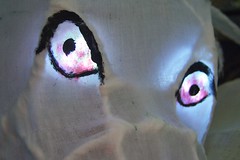 The eyes are illuminated with the same kind of cheap push-on lights I used for Mashi‘s eyes, and Tara the tapir’s brain. I mounted them on wire, with several extra pieces of gaffer tape for stability. The lights are pretty unreliable – they were flickering off when they got a knock, before I put them in – but in the end they made it through the night without any problems.
The eyes are illuminated with the same kind of cheap push-on lights I used for Mashi‘s eyes, and Tara the tapir’s brain. I mounted them on wire, with several extra pieces of gaffer tape for stability. The lights are pretty unreliable – they were flickering off when they got a knock, before I put them in – but in the end they made it through the night without any problems.

Hati meets the Cailleach. Photo by Raini Scott.
The front legs are made from strips of the white cotton, plus a sheet of muslin for the upper part. They are attached to paws made of wire and bound in cotton, with claws made of Fimo Air Light and coated in PVA glue for shininess and waterproofing. The paws are attached to sticks of bamboo for control. Inspired by careful observation of Muppets in action, I made sure that I could control both arms with one hand, with the sticks crossed over, leaving my other hand free to operate the mouth and head.
The fangs are made from the same air-drying clay as the claws, while the rest of the teeth are just torn-up tissue paper and PVA, formed around a little cone of plastic sheeting and then immediately removed. This technique allowed me to make as many teeth as I wanted very quickly.
One of the bits that I left till last, in case I ran out of time, was the hind legs. These aren’t really part of the puppet; I just sewed tubes of muslin around each of the shoulder straps, hiding the incongruous blue plastic. Then I cut a series of slits at the bottom of the muslin, and using PVA I very quickly formed the ends of the cloth into little claw shapes.
Here’s the finished puppet in action, indoors.
And here are some clips from the night itself: clip 1, clip 2, clip 3.
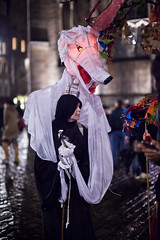 I was hugely impressed with everyone’s puppets in the end. My co-wolf Zoë did me proud; Ross’s three-person ice giant was a wonder, with its disembodied head and articulated hands on mighty poles, as was Darren’s one-person murder of crows; Helen’s lion, Frank’s pirate, Karin’s firefly, Kay’s moth queen, Morag’s Kali, Neil’s headless hobbyhorseman, Judy’s nightmare and Franzi’s tree were all things of beauty.
I was hugely impressed with everyone’s puppets in the end. My co-wolf Zoë did me proud; Ross’s three-person ice giant was a wonder, with its disembodied head and articulated hands on mighty poles, as was Darren’s one-person murder of crows; Helen’s lion, Frank’s pirate, Karin’s firefly, Kay’s moth queen, Morag’s Kali, Neil’s headless hobbyhorseman, Judy’s nightmare and Franzi’s tree were all things of beauty.
Many thanks to everyone in the group – and to all the photographers who took great photos, and everyone else involved as performers, tech, stewards or audience members. I had one of the best nights.
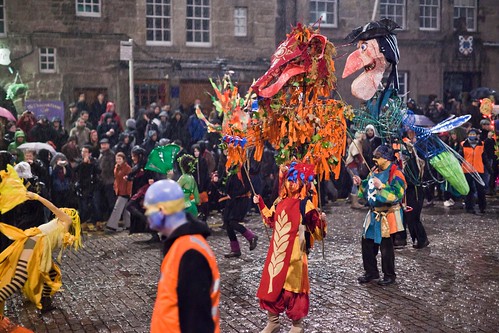
Summer puppets. This and previous photo by Chris Scott



